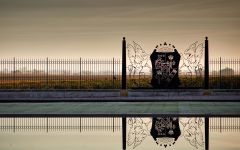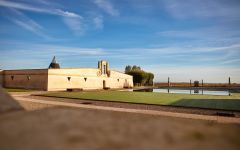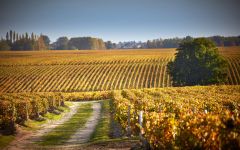Chateau Pichon-Longueville Baron (Futures Pre-Sale) 2022
-
Jeb
Dunnuck -
Robert
Parker -
James
Suckling - Decanter



Product Details
Your Rating
Somm Note
Winemaker Notes
Professional Ratings
-
Jeb Dunnuck
I loved the Grand Vin 2022 Château Pichon-Longueville Baron, which is based on 81% Cabernet Sauvignon and 19% Merlot that will spend 18 months in 70% new oak. It's not the most showy or exuberant 2022, yet it shines for its incredible class and purity, as well as balance. It has a Cabernet Sauvignon-dominated profile (no surprise) with its focused, precise, inward style that still brings gorgeous depth and richness. Cassis, graphite, espresso roast, crushed stone and spring flowers are just some of its nuances, and where many 2022s are broad and mouth-filling, this stays tight, compact, and focused, with a wonderful mix of elegance, concentration, and richness. The 2022 is pulled from 48% of the total production, and it's going to warrant 7-8 years of bottle age and have 50+ years of overall longevity.
Barrel Sample: 96-98 -
Robert Parker's Wine Advocate
An unusually gourmand, sensual wine from this estate, the 2022 Pichon-Longueville Baron bursts with aromas of crème de cassis, sweet dark berries, licorice, lilac and pencil shavings. On the palate, it's medium to full-bodied, layered and velvety, with excellent concentration and a rather rich, supple profile. A blend of 81% Cabernet Sauvignon and 19% Merlot, it's the result of sub-block by sub-block picking and cooler than usual fermentation temperatures.
Barrel Sample: 95-97 -
James Suckling
A very structured and racy PB with blackcurrant, stone and black cherry aromas and flavors. Medium to full body with racy and fine tannins that are precise and focused. Elegance with structure. 81% cabernet sauvignon and 19% merlot.
Barrel Sample: 96-97 -
Decanter
Beautiful fragrance, lots of fresh and ripe black and red bramble fruit - so alive and expressive on the nose with liquorice, wet stones and cedar spicing. Smooth, ample and full in the mouth, but not overly textured or plush. There’s a real refinement to the tannic structure, clearly giving the frame to the wine but detailed and precise with edges of liquorice, slate, dark chocolate, cedar and tobacco. It balances richness, intensity and concentration with sleekness, bright acidity and a real charm to the juicy fruit. Rich and tense, just giving a hint of it’s potential, clearly powerful but totally seductive too. A sublime wine in the making. Ageing 18 months in French oak, 70% new, 600% one wine.br>Barrel Sample: 97
Other Vintages
2021-
James
Suckling -
Robert
Parker - Decanter
-
Jeb
Dunnuck
-
James
Suckling -
Jeb
Dunnuck - Decanter
- Vinous
-
Wine
Enthusiast -
Robert
Parker -
Wilfred
Wong -
Wine
Spectator
-
Wine
Enthusiast -
Wilfred
Wong - Decanter
-
Robert
Parker -
James
Suckling -
Jeb
Dunnuck -
Wine
Spectator
-
Wilfred
Wong -
Wine
Enthusiast - Decanter
-
Jeb
Dunnuck -
Robert
Parker -
Wine
Spectator -
James
Suckling
-
Wine
Enthusiast -
Jeb
Dunnuck -
James
Suckling -
Robert
Parker -
Wine
Spectator - Decanter
- Decanter
-
James
Suckling -
Robert
Parker -
Wine
Enthusiast -
Jeb
Dunnuck -
Wine
Spectator
- Decanter
-
Wine
Enthusiast -
Jeb
Dunnuck -
Robert
Parker -
Wilfred
Wong -
James
Suckling -
Wine
Spectator -
Connoisseurs'
Guide
-
Wilfred
Wong -
Jeb
Dunnuck -
James
Suckling -
Robert
Parker - Decanter
-
Wine
Spectator
-
Jeb
Dunnuck -
James
Suckling -
Robert
Parker -
Wine
Spectator
-
Wine
Enthusiast -
Wine
Spectator -
James
Suckling -
Robert
Parker -
Jeb
Dunnuck
-
Jeb
Dunnuck -
Wine
Enthusiast -
Robert
Parker -
James
Suckling -
Wine
Spectator
- Decanter
-
Robert
Parker -
Wine
Enthusiast -
Wine
Spectator -
James
Suckling
-
Robert
Parker -
James
Suckling -
Wine
Spectator
-
Robert
Parker
-
James
Suckling -
Connoisseurs'
Guide -
Wine
Spectator -
Robert
Parker
-
Wine &
Spirits -
Connoisseurs'
Guide -
Jeb
Dunnuck -
Wine
Spectator -
Robert
Parker
-
Wine
Enthusiast -
Wine &
Spirits -
Robert
Parker
-
James
Suckling -
Wine
Spectator -
Robert
Parker -
Wine
Enthusiast
-
Wine
Spectator
-
Robert
Parker -
Wine
Spectator -
Wilfred
Wong
-
Jeb
Dunnuck -
Robert
Parker -
James
Suckling -
Wine
Spectator -
Wine
Enthusiast
-
Robert
Parker
-
Wine &
Spirits -
Robert
Parker
-
Robert
Parker -
Wine
Spectator
-
Robert
Parker -
Wine
Spectator
-
Robert
Parker - Decanter
-
Wine
Spectator
-
James
Suckling -
Wine
Spectator -
Robert
Parker
-
Wine
Spectator -
Robert
Parker







The Estate was founded in the late 17th Century. This period was known as the Grand Siecle, or "great century", in reference to Louis XIV's 1661 accession to the French throne. In 1689 Pierre Desmezures de Rauzan, an influential wine merchant and steward of the prestigious Latour and and Margaux estates, bought plots of vines close to the Latour estate to create Enclos Rauzan. These vines were part of his daughter Therese's dowry when she married Baron Jacques Pichon de Longueville in 1694, the year in which the Pichon Baron estate was founded. An illustrious estate, with an enduring reputation, was born. It remained in the same family for generations.
In 1850 the property was divided in two. Baron Raoul Pichon de Longueville's section became the Pichon Baron estate. The second section, belonging to his three sisters, became Pichon Comtesse. Baron Raoul was proud of his prestigious property, and in 1851 he commissioned the imposing chateau inspired by Renaissance architecture that we know today. This uniquely charming and romantic chateau, with its two emblematic turrets, has stood proudly at the vineyard's heart ever since. During the Universal Exhibition of 1855, the wine was classed as a Second Grand Cru Classe according to the ranking system requested by Emperor Napoleon III, who wished to showcase Bordeaux's great wines. In 1933, the Pichon de Longueville family sold the property to the Bouteiller family, who managed the chateau for over 50 years.
In 1987 the estate was bought by AXA Millesimes, whose aim is to enable great wines from the vineyards with a glorious past to achieve their full potential. An architectural competition was launched in collaboration with the Paris Pompidou Centre to provide the estate with new operational buildings. The comprehensive reconstruction of the fermenting room and cellar, and renovation of the chateau, began in 1988. Since then, the 19th century chateau's image has been
reflected in an ornamental pool stretching majestically before it.. And since 2008, its silvery expanse conceals an underground cellar, reminiscent of Jules Verne's Nautilus, with view of both the water and sky. The barrel cellar complements a production process in which excellence is paramount, in the finest tradition of great Pauillac wines.

One of the world’s most classic and popular styles of red wine, Bordeaux-inspired blends have spread from their homeland in France to nearly every corner of the New World. Typically based on either Cabernet Sauvignon or Merlot and supported by Cabernet Franc, Malbec and Petit Verdot, the best of these are densely hued, fragrant, full of fruit and boast a structure that begs for cellar time. Somm Secret—Blends from Bordeaux are generally earthier compared to those from the New World, which tend to be fruit-dominant.

The leader on the Left Bank in number of first growth classified producers within its boundaries, Pauillac has more than any of the other appellations, at three of the five. Chateau Lafite Rothschild and Mouton Rothschild border St. Estephe on its northern end and Chateau Latour is at Pauillac’s southern end, bordering St. Julien.
While the first growths are certainly some of the better producers of the Left Bank, today they often compete with some of the “lower ranked” producers (second, third, fourth, fifth growth) in quality and value. The Left Bank of Bordeaux subscribes to an arguably outdated method of classification that goes back to 1855. The finest chateaux in that year were judged on the basis of reputation and trading price; changes in rank since then have been miniscule at best. Today producers such as Chateau Pontet-Canet, Chateau Grand Puy-Lacoste, Chateau Lynch-Bages, among others (all fifth growth) offer some of the most outstanding wines in all of Bordeaux.
Defining characteristics of fine wines from Pauillac (i.e. Cabernet-based Bordeaux Blends) include inky and juicy blackcurrant, cedar or cigar box and plush or chalky tannins.
Layers of gravel in the Pauillac region are key to its wines’ character and quality. The layers offer excellent drainage in the relatively flat topography of the region allowing water to run off into “jalles” or streams, which subsequently flow off into the Gironde.
